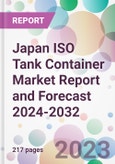According to the report, the Japan ISO tank container market is projected to grow at a CAGR of 7.3% between 2024 and 2032 reaching a value of approximate USD 1.7 billion by 2032.. Aided by the growing need for efficient, reliable, and cost-effective transportation solutions in various industries, the market is expected to grow significantly by 2032.
ISO Tank Containers are large capacity, stainless steel tanks held within a reinforced framework that complies with ISO (International Organisation for Standardisation) standards. These containers are designed to carry both hazardous and non-hazardous liquids, including chemicals, food-grade liquids, and gases. They offer significant advantages such as easy loading, unloading, and transloading, excellent safety features, and long-term durability, making them a vital component in various industrial applications, including chemicals, oil and gas, and food and beverages.
The increasing need for efficient transportation solutions is driving the Japan ISO tank container market growth. With the rise in global trade and the increasing complexity of supply chains, there has been a significant shift towards more effective and versatile transportation options, leading to an upswing in demand for ISO Tank Containers. Additionally, the growing trend of digitisation and automation in logistics and supply chain management has further contributed to the market expansion, as ISO Tank Containers are compatible with these technological advancements.
The diverse applications of ISO Tank Containers in various industries play a significant role in propelling the Japan ISO tank container market development. In the chemical industry, these containers are used for their ability to transport hazardous and non-hazardous chemicals safely and efficiently. The oil and gas industry utilises ISO Tank Containers due to their capability to handle high-pressure gases and liquids. Moreover, the food and beverage industry leverage these containers for their hygienic and food-grade material, essential for transporting consumable liquids.
Furthermore, the growing emphasis on sustainability in the transportation industry has led to an increased focus on ISO Tank Containers. These containers provide an environmentally friendly option as they are reusable and reduce the overall waste and resources used in shipping. With the rising environmental consciousness and the increasing regulatory pressure for sustainable practices, ISO Tank Containers are emerging as a popular choice in the industry, thereby boosting the Japan ISO tank container market demand.
ISO Tank Containers are large capacity, stainless steel tanks held within a reinforced framework that complies with ISO (International Organisation for Standardisation) standards. These containers are designed to carry both hazardous and non-hazardous liquids, including chemicals, food-grade liquids, and gases. They offer significant advantages such as easy loading, unloading, and transloading, excellent safety features, and long-term durability, making them a vital component in various industrial applications, including chemicals, oil and gas, and food and beverages.
The increasing need for efficient transportation solutions is driving the Japan ISO tank container market growth. With the rise in global trade and the increasing complexity of supply chains, there has been a significant shift towards more effective and versatile transportation options, leading to an upswing in demand for ISO Tank Containers. Additionally, the growing trend of digitisation and automation in logistics and supply chain management has further contributed to the market expansion, as ISO Tank Containers are compatible with these technological advancements.
The diverse applications of ISO Tank Containers in various industries play a significant role in propelling the Japan ISO tank container market development. In the chemical industry, these containers are used for their ability to transport hazardous and non-hazardous chemicals safely and efficiently. The oil and gas industry utilises ISO Tank Containers due to their capability to handle high-pressure gases and liquids. Moreover, the food and beverage industry leverage these containers for their hygienic and food-grade material, essential for transporting consumable liquids.
Furthermore, the growing emphasis on sustainability in the transportation industry has led to an increased focus on ISO Tank Containers. These containers provide an environmentally friendly option as they are reusable and reduce the overall waste and resources used in shipping. With the rising environmental consciousness and the increasing regulatory pressure for sustainable practices, ISO Tank Containers are emerging as a popular choice in the industry, thereby boosting the Japan ISO tank container market demand.
Market Segmentation
The market can be divided based on transport mode, container type, and application.Market Breakup by Transport Mode
- Road
- Rail
- Marine
Market Breakup by Container Type
- Dry Container
- Thermal and Refrigerated Container
- Tank Container
- Open Top Container
- Insulated Container
- Flat Rack Container
- Others
Market Breakup by Application
- Chemicals
- Petrochemicals
- Food and Beverage
- Pharmaceuticals
- Industrial Gas
- Others
Competitive Landscape
The report looks into the market shares, plant turnarounds, capacities, investments, and mergers and acquisitions, among other major developments, of the leading companies operating in the Japan ISO tank container market. Some of the major players explored in the report are as follows:- Japan Oil Transportation (JOT)
- NRS Corporation
- Nippon Marine Logistics, Ltd.
- Sinotrans Japan Co., Ltd.
- Manock Industry Co.,Ltd.
- Others
Table of Contents
1 Preface2 Report Coverage - Key Segmentation and Scope4 Key Assumptions7 Opportunities and Challenges in the Market10 Value Chain Analysis12 Key Trends and Developments in the Market
3 Report Description
5 Executive Summary
6 Snapshot
8 Japan ISO Tank Container Market Analysis
9 Market Dynamics
11 Competitive Landscape
List of Key Figures and Tables
Companies Mentioned
- Japan Oil Transportation(JOT)
- NRS Corporation
- Nippon Marine Logistics ltd
- Sinotrans Japan Co.Ltd.
- Manock Industry Co.Ltd.
Methodology

LOADING...








